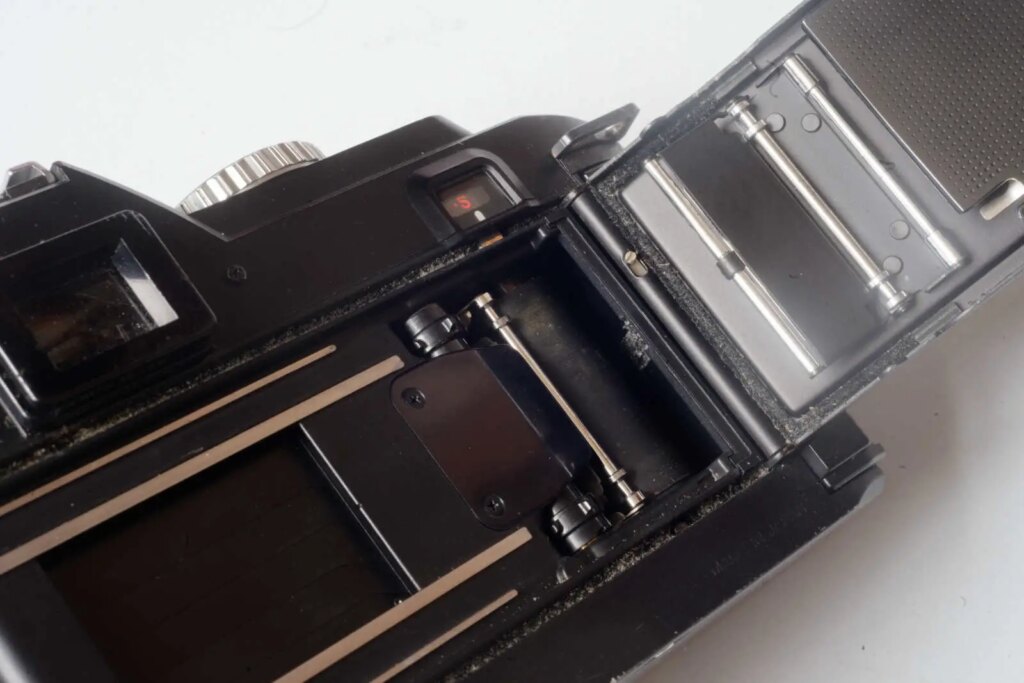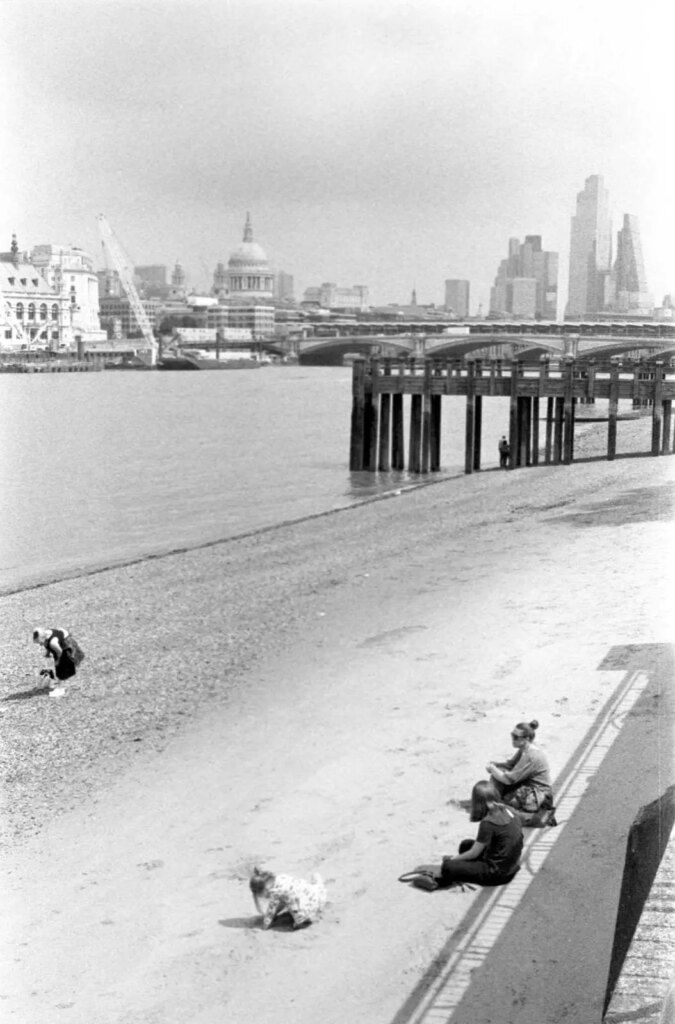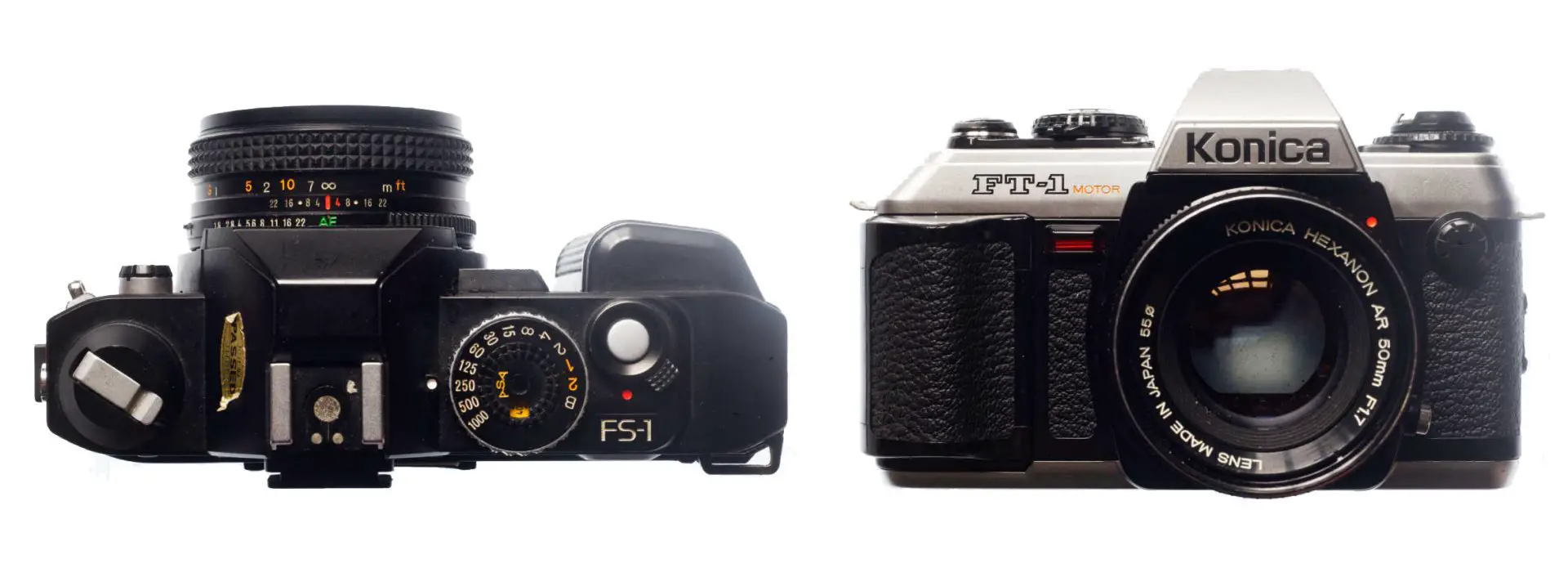Konica produced Sakura film (later simply rebranded to ‘Konica’). They were the second-largest film producer in Japan after Fujifilm. As well as their own films, they produced films for lots of third parties. They had every good business reason to encourage rapid winding and exposure of their product.
In 1979 Konica produced a landmark camera with a winder.
It was not the first SLR with a built-in winder (that was the unmetered Minolta SR-M), but the FS-1 was the first automatic SLR to feature the winder integrated into the body (rather than bolted on the bottom). It also eliminated the manual wind-on lever. With a generous grip for the right hand to house the alkaline batteries required, It had a profile that was ahead of its time, but which now seems rather familiar.

The upside
The result was radical. It led a trend. Ergonomically it was lovely. It used motors in the body. Not just to wind the film. There was a separate motor to drive the mirror up and down, rather than relying on sprung tensioners. It had no manual wind-on lever: without batteries the camera would not work in any case. The rear of the shutter speed dial falls against your thumb and is easy enough to turn that it almost works like a modern control dial. It had a genuinely easy-to-use automatic loading system that just required you to lay the film across the camera and close the rear door.

The FS-1 had LED indicators in the viewfinder. They showed speeds for an electronically controlled shutter as determined by a Gallium Arsenide Phosphor sensor. It had a shutter release with minimal travel and an electronic remote socket connection on the left of the body that took a wired remote release.

In a blow struck for minorities, it also had an accessory that fitted into the remote socket to allow left-handed operation. It has to be said that I’ve never actually seen one of these left-handed releases, but they do seem to have existed and may have been a boon to some photographers. It is a shame that the FS-1 provides so little body to grip with the left hand through.
The downside
Unfortunately, the baby got thrown away with the bathwater.
When this camera was first released, I had just got a regular job and was looking to add a second body to go with my trusty T3. I went to a photographic exhibition at Kensington Olympia and tried out the FS-1. I loved it. It made all the right whizzy autowinder noises to appeal to a guy in his late teens. There was a problem that I noticed straight away though. I found it very difficult to take just one shot.
There was no single/continuous switch. There was also no exposure lock. It didn’t feature an exposure compensation dial. The only way of catering for backlight was to adjust the set film speed.
It was an engineering and ergonomic marvel, but a bit disappointing for a photographer. Contax released their 137 the next year. The Contax had a built-in winder with a single/continuous switch, exposure lock and compensation dial.
My meagre wages were not able to support running through film at the rate that I would have with the FS-1. I ended up buying an Autoreflex TC.
Conventional backup
Konica covered their backs by producing a sister model the following year. The FC-1 had a conventional wind-on and the option of an autowinder that bolted on to the bottom of the body. I’ve never used one, but it seems to me that it shares much that is wrong with the FS-1 with fewer of the ergonomic saving graces. Another follow-up was the FP-1 program which was pretty much the same camera, but without any control of the exposure system.
A saving grace
In 1983 Konica discontinued all of their current SLR models and introduced the FT-1 Motor.

You could have a large grip with AA batteries, or the smaller standard one fitted with AAA batteries. The FT-1 fixes a lot of the issues with the FS-1. It has a switch for single or continuous drive. As well as an exposure lock, it has a compensation dial. It is the camera Konica should have produced four years earlier.

It still didn’t have depth of field preview or speeds in the viewfinder, and although they had done programmed exposure in the FP-1, they didn’t offer multimode exposure here.
The FS-1 and FT-1 motor in practice.
Ergonomically these are lovely cameras and with its extra controls the FT-1 Motor is a highly capable photographer’s camera. The lack of a depth-of-field preview is a shame. I can only guess that the complications of dealing with a new metering system and an autowinder was seen as an adventure too far. The tripod bush is way off the line of the lens, but is quite acceptable in use.

Controls fall easily to hand, with the shutter speed selector on both cameras being easily operable by the thumb of the right hand. Operation of the exposure lock on the FT-1 Motor is more awkward than it was on earlier trap-needle Konica SLRs, but after its omission on the FS-1, I’m just glad to see it reappear.
The automatic film loading really works well. Flash synch is lower than earlier cameras; limited to 1/60 for most flashes. The camera will automatically set synch to 1/100 when certain dedicated Konica flashes are attached and ready to fire, but those flashes are going to be hen’s-teeth rare 40 years on.

On the whole these are well-built cameras, and you get a real feeling of solidity.
These were, however, relatively early electronic devices and it shows.
FS-1
The electronics of the FS-1 are very sensitive to voltage. It is possible to ‘fry’ the circuitry by using batteries that produce less than the optimal 6v. This sounds a bit counter-intuitive, but apparently some components will work at a lower voltage, but others won’t. If they are not all working together, it can over-stress the system. There is a clear warning in the battery compartment to avoid 1.2v NiCd batteries. There is also the possibility over time that the dropping voltage curve of alkaline batteries will damage the camera. The camera should shut itself down before it gets to this point, but a lot of FS-1 cameras seem to have fried meters.

I have three FS-1 cameras. Only one has consistently working LEDs in the viewfinder. The motors can also be an issue. The FS-1 was produced in three main batches. Each became more reliable. Serial numbers below 345000 are regarded as most delicate, while those over 420000 are supposed to be the most reliable. Perversely, my best FS-1 is an early one…

FT-1 Motor
Twenty years ago I was shooting a wedding for a family friend and both my normally reliable mechanical Konica SLRs developed faults. My father saved the day by handing me his FT-1 Motor. Now that camera has come to me, and I’m sorry to say the meter no longer works. It also seems to need a definite rest between exposures. It is sad that my dad’s old FT-1 Motor seems to have succumbed to age.
There are reports that, due to corrosion and the breakdown of gaskets, the connections between flexible circuit boards used under the top cover of the FT-1 Motor can deteriorate. The internet suggests that the gaskets can be replaced and that the connections can be cleaned up. I haven’t tried it yet. In the interim I’m using the FT-1 Motor as a manual exposure camera.

Pictures
Please note that lenses used are from memory (how we come to rely of EXIF…)
FS-1






FT-1 Motor






Conclusion
Innovative and reliable are not necessarily natural bed-fellows. If you pick up either of these cameras without them having been film tested, be aware that there is potential for issues with the electronics.
Share this post:









Comments
MICHAEL on Konica FS-1 and FT-1 review – The Shape of Things to Come
Comment posted: 07/07/2023
Comment posted: 07/07/2023
Bob Janes on Konica FS-1 and FT-1 review – The Shape of Things to Come
Comment posted: 07/07/2023
Castelli Daniel on Konica FS-1 and FT-1 review – The Shape of Things to Come
Comment posted: 07/07/2023
I never used Konica cameras, but in 1981 I grabbed my ideal job: I was hired to teach both graphic design & photography at a small high school in Connecticut. The school system had purchased Konica TC cameras w/50mm lenses. They were great student cameras! Tough little buggers. I recall one student having the TC-1, he shot lots of skate board action. I remember him because he went on to shoot freelance for Newsweek magazine after serving in the US Army as a filmmaker. The Konica was more of a user friendly camera; it took over 5 years of hard student wear/abuse to kill them off.
Comment posted: 07/07/2023
Tejima on Konica FS-1 and FT-1 review – The Shape of Things to Come
Comment posted: 08/07/2023
Mine is in absolute mint condition. Works flawlessly for 4 years I own it now. The copal shutter of this camera is amazing... best of the best. Other electronics desire better. Exposure tend to under-expose... But otherwise for me - a gem of a camera...if you can find it in better condition.
Comment posted: 08/07/2023
Bob Janes on Konica FS-1 and FT-1 review – The Shape of Things to Come
Comment posted: 09/07/2023
Roman on Konica FS-1 and FT-1 review – The Shape of Things to Come
Comment posted: 10/07/2023
The construction of these bodies and shutters lives almost to this day, in Voigtlander Bessa cameras...
Comment posted: 10/07/2023
David Money on Konica FS-1 and FT-1 review – The Shape of Things to Come
Comment posted: 07/11/2023